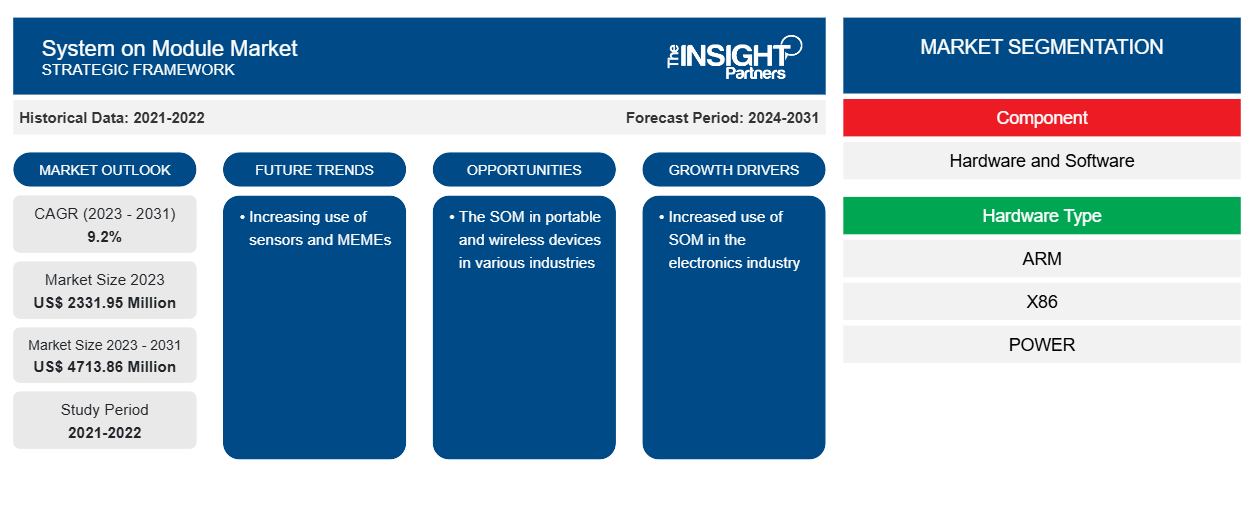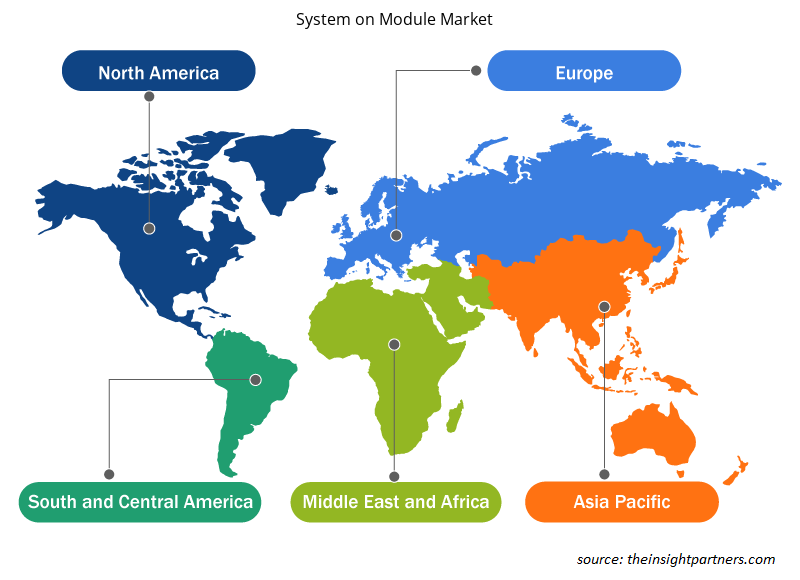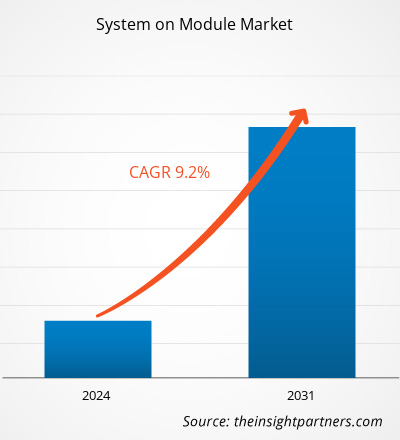The system module market size is projected to reach US$ 4713.86 million by 2031 from US$ 2331.95 million in 2023. The market is expected to register a CAGR of 9.2% during 2023–2031. Increasing use of sensors and MEMEs is likely to remain a key trend in the market.
System on Module Market Analysis
The worldwide lockdown to reduce the transmission of the virus has significantly disrupted the supply chain activities and production capacity across several manufacturers, particularly small and medium enterprise owners. The semiconductor industry was a significant contributor to the demand for electronic components from the industrial sector and end users. The revenue model for microelectronics has declined due to the lack of mass production during the lockdown period. The semiconductor industry gradually regained market share as production facilities restarted their operations by taking social distancing measures. Additionally, work-from-home and remote monitoring strategies also increased the sales of advanced electronics products for improved connectivity. IT and telecommunication industry importance have been highlighted for the communicational purpose, which acknowledged the industry to evolve with new technologies such as high-speed Wi-Fi compatible packaging technology.
System on Module Market Overview
A System-on-Module (SOM) presents the core components of an embedded processing system, such as memory blocks, communication interfaces, and processor cores, on a single production-ready printed circuit board (PCB). This modular approach makes a SOM suitable for embedding in end systems, from robots to security cameras. The concept of System-on-Modules evolved from blade servers. These thin servers were created to save storage space and reduce power consumption. The architecture of SOMs influences the lean design mentality behind blade servers. They include only the components required for their intended function in as small a package as possible, and they’re flexible enough to accommodate a wide range of applications.
Customize This Report To Suit Your Requirement
You will get customization on any report - free of charge - including parts of this report, or country-level analysis, Excel Data pack, as well as avail great offers and discounts for start-ups & universities
System on Module Market: Strategic Insights

- Get Top Key Market Trends of this report.This FREE sample will include data analysis, ranging from market trends to estimates and forecasts.
You will get customization on any report - free of charge - including parts of this report, or country-level analysis, Excel Data pack, as well as avail great offers and discounts for start-ups & universities
System on Module Market: Strategic Insights

- Get Top Key Market Trends of this report.This FREE sample will include data analysis, ranging from market trends to estimates and forecasts.
System on Module Market Drivers and Opportunities
Increased use of SOM in the electronics industry
As flexible core components, SOMs enable rapid development across various technological applications, from consumer electronics to industrial automation, making them essential in modern product design. In the rapidly evolving environment of electronics product design, the System on Module (SoM) methodology has emerged as a key source of transformation. As a result of its compact size, high performance, and cost-effectiveness, SoM is becoming a popular choice among designers and engineers. Therefore, the increased use of SOM in the electronics industry is driving market growth.
The SOM in portable and wireless devices in various industries
SoMs are used in portable medical devices where reliability and compactness are critical. For example, an SoM might be integrated into a handheld ultrasound device, providing the necessary processing power and connectivity in a compact form factor. SoMs are employed in advanced driver-assistance systems (ADAS) where they provide high-performance computing capabilities needed for real-time processing of sensor data. In industrial settings, SoMs are used in programmable logic controllers (PLCs) and human-machine interfaces (HMIs), offering robust and scalable solutions for complex automation tasks.
System on Module Market Report Segmentation Analysis
Key segments that contributed to the derivation of the system on module market analysis are component, hardware type, and application.
- Based on the component, the system on the module market is divided into hardware and software. The standard probe card segment held a larger market share in 2023.
- By hardware type, the market is segmented into arm, X86, POWER, FPGA, GPU, DSP, and RISC-V. The surface-mounted segment held a larger market share in 2023.
- By application, the market is segmented into industrial automation, entertainment, medical, transportation, test and measurement, video application, and others.
System on Module Market Share Analysis by Geography
The geographic scope of the system on the module market report is mainly divided into five regions: North America, Asia Pacific, Europe, Middle East & Africa, and South & Central America.
APAC dominates the system on module market. Many of the APAC countries are characterized by the quantity of electronic devices required for automotive components, telecommunication devices, consumer electronics, and other industrial types of machinery. The growing number of electronics manufacturing companies in China and India, due to the strong accessibility of skilled human resources, is driving the system on module market.
System on Module Market Regional Insights
The regional trends and factors influencing the System on Module Market throughout the forecast period have been thoroughly explained by the analysts at The Insight Partners. This section also discusses System on Module Market segments and geography across North America, Europe, Asia Pacific, Middle East and Africa, and South and Central America.

- Get the Regional Specific Data for System on Module Market
System on Module Market Report Scope
| Report Attribute | Details |
|---|---|
| Market size in 2023 | US$ 2331.95 Million |
| Market Size by 2031 | US$ 4713.86 Million |
| Global CAGR (2023 - 2031) | 9.2% |
| Historical Data | 2021-2022 |
| Forecast period | 2024-2031 |
| Segments Covered |
By Component
|
| Regions and Countries Covered | North America
|
| Market leaders and key company profiles |
System on Module Market Players Density: Understanding Its Impact on Business Dynamics
The System on Module Market is growing rapidly, driven by increasing end-user demand due to factors such as evolving consumer preferences, technological advancements, and greater awareness of the product's benefits. As demand rises, businesses are expanding their offerings, innovating to meet consumer needs, and capitalizing on emerging trends, which further fuels market growth.
Market players density refers to the distribution of firms or companies operating within a particular market or industry. It indicates how many competitors (market players) are present in a given market space relative to its size or total market value.
Major Companies operating in the System on Module Market are:
- Microchip Technology
- Inc.
- Advantech Co. Ltd.
- SoMLabs
- Axiomtek Co. Ltd.
- Connect Tech Inc.
Disclaimer: The companies listed above are not ranked in any particular order.

- Get the System on Module Market top key players overview
System on Module Market News and Recent Developments
The system on module market is evaluated by gathering qualitative and quantitative data post primary and secondary research, which includes important corporate publications, association data, and databases. A few of the developments in the system on the module market are listed below:
- Toradex, a leading embedded systems solutions provider, launched its newest family of pin-compatible and scalable Systems on Modules (SoMs) - Aquila. (Source: Toradex, Press Release, April 2024)
- NetBurner announced the launch of its latest solution, the SOMRT1061 system-on-module (SOM). With performance in a small 25.4mm size, it’s ideal for use as a main system processor, a network sub-processor, or even an encrypted Serial to Ethernet server. (Source: NetBurner, Press Release, May 2024)
System on Module Market Report Coverage and Deliverables
The “System on Module Market Size and Forecast (2021–2031)” report provides a detailed analysis of the market covering below areas:
- System on module market size and forecast at global, regional, and country levels for all the key market segments covered under the scope
- System on module market trends as well as market dynamics such as drivers, restraints, and key opportunities
- Detailed PEST/Porter’s Five Forces and SWOT analysis
- system on module market analysis covering key market trends, global and regional framework, major players, regulations, and recent market developments
- Industry landscape and competition analysis covering market concentration, heat map analysis, prominent players, and recent developments for the system on module market
- Detailed company profiles
Frequently Asked Questions
What is the expected CAGR of the system on module market?
The expected CAGR of the global system on module market is 9.2%.
What would be the estimated value of the system on module market by 2031?
The global system on module market is expected to reach US$ 4713.86 million by 2031
What are the future trends of the system on module market?
The increasing use of sensors and MEMEs is anticipated to play a significant role in the global system on module market in the coming years.
Which are the leading players operating in the system on module market?
The key players holding majority shares in the global system on module market are Microchip Technology, Inc., Advantech Co. Ltd., SoMLabs, Axiomtek Co., Ltd., Connect Tech Inc., National Instruments Corporation, MAC, Inc., congatec GmbH, AAEON, Emcraft Systems, MIPS Technologies Inc., SiFive Inc., and Segate Technology LLC.
What are the driving factors impacting the system on module market?
Increased use of SOM in the electronics industry and the SOM in portable and wireless devices in various industries are the major factors that propel the global system on module market.
Which region dominated the system on module market in 2023?
APAC dominates the system on module market.
- Historical Analysis (2 Years), Base Year, Forecast (7 Years) with CAGR
- PEST and SWOT Analysis
- Market Size Value / Volume - Global, Regional, Country
- Industry and Competitive Landscape
- Excel Dataset
Testimonials
Reason to Buy
- Informed Decision-Making
- Understanding Market Dynamics
- Competitive Analysis
- Identifying Emerging Markets
- Customer Insights
- Market Forecasts
- Risk Mitigation
- Boosting Operational Efficiency
- Strategic Planning
- Investment Justification
- Tracking Industry Innovations
- Aligning with Regulatory Trends
Yes! We provide a free sample of the report, which includes Report Scope (Table of Contents), report structure, and selected insights to help you assess the value of the full report. Please click on the "Download Sample" button or contact us to receive your copy.
Absolutely — analyst assistance is part of the package. You can connect with our analyst post-purchase to clarify report insights, methodology or discuss how the findings apply to your business needs.
Once your order is successfully placed, you will receive a confirmation email along with your invoice.
• For published reports: You’ll receive access to the report within 4–6 working hours via a secured email sent to your email.
• For upcoming reports: Your order will be recorded as a pre-booking. Our team will share the estimated release date and keep you informed of any updates. As soon as the report is published, it will be delivered to your registered email.
We offer customization options to align the report with your specific objectives. Whether you need deeper insights into a particular region, industry segment, competitor analysis, or data cut, our research team can tailor the report accordingly. Please share your requirements with us, and we’ll be happy to provide a customized proposal or scope.
The report is available in either PDF format or as an Excel dataset, depending on the license you choose.
The PDF version provides the full analysis and visuals in a ready-to-read format. The Excel dataset includes all underlying data tables for easy manipulation and further analysis.
Please review the license options at checkout or contact us to confirm which formats are included with your purchase.
Our payment process is fully secure and PCI-DSS compliant.
We use trusted and encrypted payment gateways to ensure that all transactions are protected with industry-standard SSL encryption. Your payment details are never stored on our servers and are handled securely by certified third-party processors.
You can make your purchase with confidence, knowing your personal and financial information is safe with us.
Yes, we do offer special pricing for bulk purchases.
If you're interested in purchasing multiple reports, we’re happy to provide a customized bundle offer or volume-based discount tailored to your needs. Please contact our sales team with the list of reports you’re considering, and we’ll share a personalized quote.
Yes, absolutely.
Our team is available to help you make an informed decision. Whether you have questions about the report’s scope, methodology, customization options, or which license suits you best, we’re here to assist. Please reach out to us at sales@theinsightpartners.com, and one of our representatives will get in touch promptly.
Yes, a billing invoice will be automatically generated and sent to your registered email upon successful completion of your purchase.
If you need the invoice in a specific format or require additional details (such as company name, GST, or VAT information), feel free to contact us, and we’ll be happy to assist.
Yes, certainly.
If you encounter any difficulties accessing or receiving your report, our support team is ready to assist you. Simply reach out to us via email or live chat with your order information, and we’ll ensure the issue is resolved quickly so you can access your report without interruption.





















 Get Free Sample For
Get Free Sample For